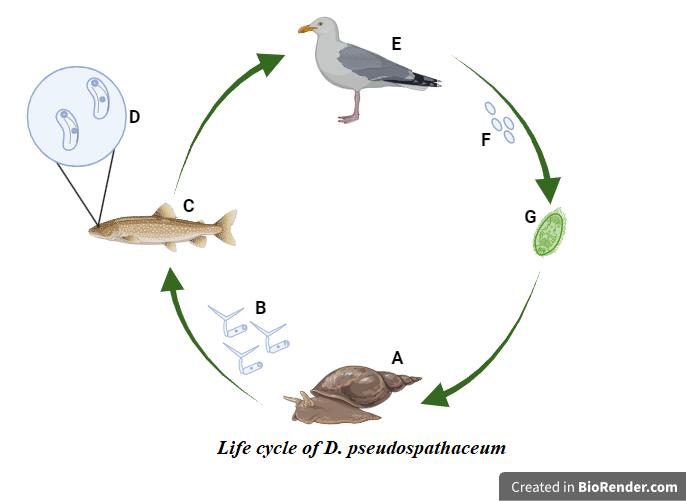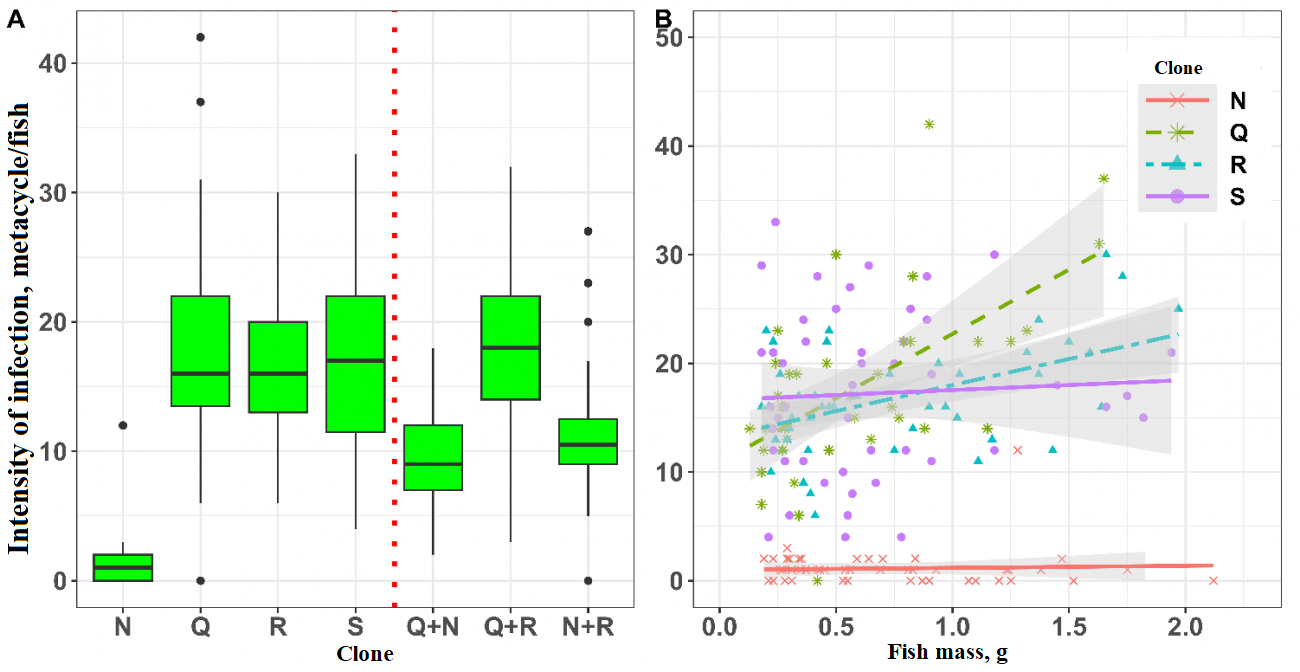
Fig. 1 (A) An infected pond snail secretes the dissemination stages of the parasite - cercariae (B), which penetrate the fish (C), damaging the lens (D). Cercariae of one line of the parasite are formed during asexual reproduction in the mollusk, and therefore are genetically identical to each other. The sexual process occurs in the intestine of a fish-eating bird (E). Eggs (F) fall into the water, where they hatch into a ciliated larva (G), capable of infecting the mollusk.
The ability of parasite clones to infect the host and their growth rate influence the evolutionary success and virulence of the parasite (the harm caused to the host). In nature, the host is often infected by several clones simultaneously, and the interactions between them can determine the course of the infection. Researchers from the Severtsov Institute of Ecology and Evolution of the Russian Academy of Sciences (IEE RAS) have studied for the first time the relationships between parasite clones at different stages of infection development (at the time of infection and during the growth of larvae in the host).
The scientists used the common trematode Diplostomum pseudospathaceum for this study. During its life cycle, this trematode consistently parasitizes pond snails, many species of freshwater fish and fish-eating birds, in whose intestines it completes its life cycle (Fig. 1).
The scientists collected large pond snails infected with the trematode D. pseudospathaceum from natural reservoirs. Microsatellite analysis was then used to determine which of these harbored only one clone of the parasite, and these mollusks were used as a source of parasites in the experiment. Dolly Varden were infected with either individual clones or pairs of clones simultaneously. After several months, the fish were dissected, and the parasites found in their lenses were counted and measured (~4,000 parasites from 364 fish!).

Fig. 2. (A) Infection rates of Dolly Varden with different clones of D. pseudospathaceum and a mixture of clones. (B) Infection rates of fish as a function of host size for different clones of the parasite. Note that the slopes of the lines differ, i.e. the clones differed in their ability to infect fish of different sizes.
As expected, the parasite clones varied in their ability to infect fish (Fig. 2A) and growth rate in their eyes. Interestingly, the scientists found evidence of clone specialization for hosts of different sizes: some clones were more successful in infecting larger hosts, while others were not (Fig. 2B). This may be evolutionarily advantageous for the parasite, since it reduces intraspecific competition for host resources. Simultaneous infection of Dolly Varden with two clones led to three different scenarios: a) facilitated parasite penetration into the host; b) slowed down parasite growth; c) had no effect, compared to monoclonal infection. Thus, when the parasite clones interacted with each other (results of bootstrap analysis), they either cooperated during infection or competed during the larval growth stage.
The most important conclusion of the work is that there is no universal answer to the question: “How will the parasite clones interact in the host organism?” It all depends on their combination. Such genotypic interactions can have a significant impact on the dynamics of infection and virulence of the parasite.
The work was carried out by a team of authors from the Center of Parasitology of the IEE RAS (Mironova E.I., Spiridonov S.E., Sotnikov D.A., Savina K.A.), the Laboratory of Behavior of Lower Vertebrates of the IPEE RAS (Gopko M.V.) and the Russian State Agrarian University - Moscow Agricultural Academy (Sotnikov D.A., Shpagina A.A.) with the support of the grant of the Russian Science Foundation (23-24-00418).
The article was published in the leading parasitological journal International Journal for Parasitology: Mironova, E., Spiridonov, S., Sotnikov, D., Shpagina, A., Savina, K., & Gopko, M. (2024). How do trematode clones differ by fitness-related traits and interact within a host?. International Journal for Parasitology.
